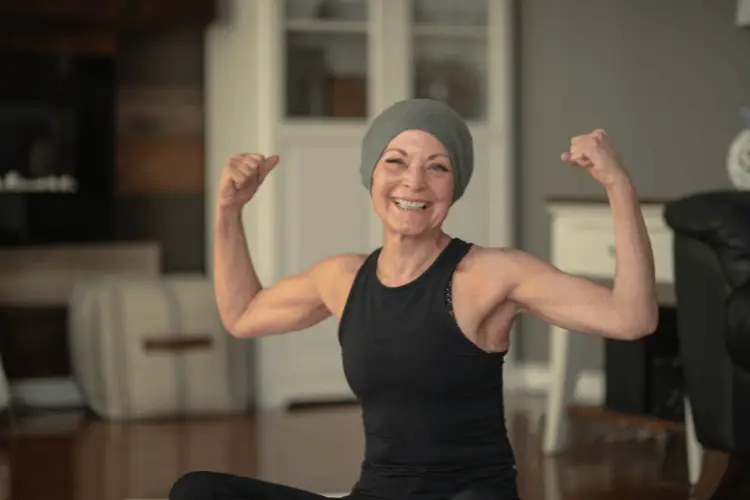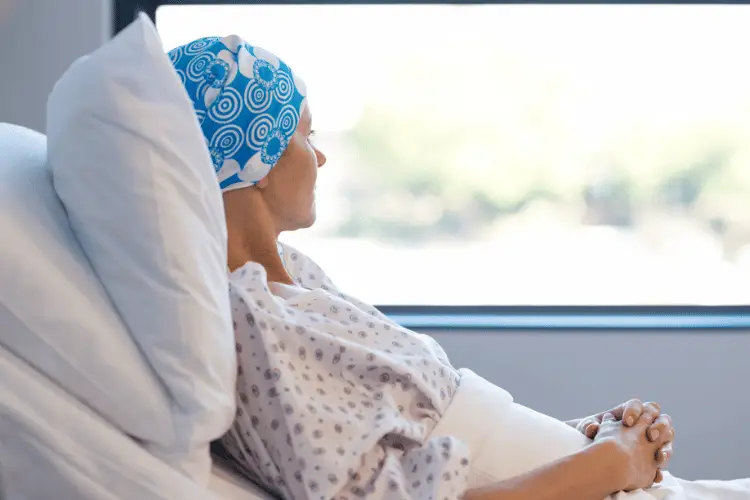When you’re going through chemotherapy and radiation or you just got done with your treatments, doing physical exercise may be the last thing on your mind.
The future could look impossible, but what if you don’t have to be alone through this hurdle? Did you know that it is quite common for cancer survivors to work with personal trainers in the gym?
And did you know that there are thousands of published articles proving the reduced risk of cancer in those who exercise?
Here, I will talk about some of the findings and discuss how having a trainer can absolutely prolong your life. This is not just a random subject that I’m writing about. I have trained cancer patients before, during and after treatment and have an intimate knowledge of the process.
I’ve driven many cancer patients to their appointments and seen how drained they were on the ride home. This is not just a “light and fun” subject when it is affecting you or a loved one.
Cancer and Exercise Statistics
Cancer is a tough pill to swallow. Here’s the hard truth about cancer and data on how exercise affects the disease.
- In 2022, 1.9 million Americans developed cancer. Out of this number, an estimated 600,000, or 31.6% of the patients passed away. (American Cancer Society)
- The good news is that studies show that physical activity can reduce the risk of death from cancer by up to 40%. (National Cancer Institute, 2020)
- Despite the good figures, only 5% of cancer patients get referred to a cancer rehab program. (Karen Wonders, PhD., 2017)
- Cancer rehabilitation is on the rise. It includes treatment through exercising under professional guidance. The number of cancer survivors is expected to reach 26 million by 2040. (National Library of Medicine, 2018)
Is Exercise Effective In Slowing Cancer?
Yes! Exercise as a treatment for cancer isn’t a new thing, but because cancer studies take several years to finish, the results are only emerging now.
The data may not be complete for every type of cancer, yet we know one thing for sure:
Physical activity is scientifically proven to reduce your risk of getting cancer. It also reduces your risk of dying if you happen to get diagnosed with cancer.
Here are some of the numbers according to The National Cancer Institute.
| Type of Cancer | Reduced Risk of Getting This Type of Cancer for People Who Do Regular Exercise |
| Bladder | 13-15% |
| Breast | 12-21% |
| Colon | 19-24% |
| Endometrial | 20% |
| Esophageal | 21% |
| Kidney | 12-23% |
| Stomach | 19% |
As you can see, the risk depends on your type of cancer. The effects aren’t equal, but in general, exercise has a positive impact on reducing your chance of getting cancer.
The table above shows that people who do intense daily exercises are less likely to develop bladder, breast, colon, endometrial, esophageal, kidney, and stomach cancers.
Moreover, researchers found that if you get cancer, your chances of survival also increase if you do regular exercise! Here’s data on the effects of exercise on cancer patients.
| Type of Cancer | Reduced Risk of Death of People Who Do Regular Exercise |
| Breast | 40% |
| Colorectal | 30% |
| Prostate | 33% |
The table above are results shared by the National Cancer Institute. It says that breast cancer survivors have a 40% less risk of dying from the disease. Plus, the numbers also look great for colorectal and prostate cancer survivors.
Because of these studies, it’s safe to say that exercise gives you a bigger chance in your battle with the disease.
What Other Types of Cancer Does Exercise Work On?
Exercise isn’t effective for all types of cancers. However, there are positive results on 13 types of cancers according to the American Cancer Society.
Physical activity increases your chance of survival from the following cancer types:
- Colon cancer
- Breast cancer
- Endometrial cancer
- Liver cancer
- Esophageal cancer
- Myeloid leukemia
- Stomach cancer
- Kidney cancer
- Myeloma or blood cancer
- Neck and head cancer
- Lung cancer
- Rectum cancer
- Bladder cancer
How Does Exercise Prevent Cancer?
Now that we know the effects of exercise on cancer, we move on to the next question: How does physical activity work against cancer? The science behind it is simple, but intriguing!
What’s the Cancer Development Process?
Cancer begins when the mitochondria of normal cells get damaged. Watch this video for an in-depth explanation.
How Does Exercise Equate to the Solution?
As shown by the video above, to combat cancer, we need to increase the oxygen levels in our bodies. More oxygen means that our cells can churn out higher amounts of ROS. The ROS will then trigger normal cell death and help slow cancer down and prevent it before it starts.
Dr. Eric Berg, the founder of the Berg Institute of Health & Wellness, says that exercise has the following effects on our body:
- Increases oxygen levels by 10 to 20 times and raises ROS by 1000 times. The improved amount of ROS helps to control and kill off cancer cells.
- Helps maintain blood sugar and insulin resistance. Insulin resistance is correlated with an increased risk of developing cancer.
- If you do outdoor exercise, you develop more vitamin D. The vitamin decreases the risk of getting cancer.
Other sources have this to add about the effects of exercise on cancer:
- Exercise lowers estrogen and growth factors that may result in the progression of breast and colon cancer. (National Cancer Institute, 2020)
- Cancer rehabilitation, exercise, and therapy decrease inflammation and have a positive effect on immune functions. (National Library of Medicine, 2013)
- In the case of colon cancer, physical activity alters the metabolism of bile acids. This lessens your gastrointestinal tract’s exposure to ingested carcinogens. (National Library of Medicine, 2009)
- Physical activity reduces obesity, which is the underlying cause of 40% of cancer cases in America. (CDC, 2022)
- Exercise lessens the side effects of chemotherapy and radiation. It helps patients recover faster with fewer complications. (MD Anderson Cancer Center, 2022)
How Can a Personal Trainer Help in Cancer Treatment?
Why should you get a personal trainer if you’re recovering from cancer? Here are three of our top reasons!
1. They Know the Right Training Regimen to Fit Your Circumstance
Exercise for cancer isn’t a one-size-fits-all type of deal. You’ll need a regimen that’s specific to you. Researchers are looking into personal-trainer-led exercises for cancer recovery because of these reasons:
- Personal trainers have the knowledge of which exercises fit you. We can educate you on what activities can raise your blood oxygen levels.
- Personal trainers work closely with your physician to come up with an exercise program and take comorbidities, like heart disease and arthritis, into account.
- Trainers follow guidelines from the American Society of Clinical Oncology for active cancer treatment. They know the limits of what you can do as a cancer patient.
- Personal trainers can work around the memory loss and brain fog caused by chemotherapy.
- We know how to make the activities fun and enjoyable for you!
2. Trainers Can Be a Source of Support
Cancer is a disease that exacts a lot of mental strain on individuals. What better support than a professional who knows how to motivate you?
This is why you should seek help with your workouts when you’re recovering from cancer.
- Among cancer patients, 18% in the active anti-tumor phase develop anxiety and mood disorders, while 35% to 52% are in general distress. (Oxford University Press, 2020)
- 35% experience a moderately high degree of loneliness and 50% said that they have high degrees of loneliness. Those with comorbidities are more affected by mental issues caused by cancer. (American Journal of Managed Care, 2021)
- Out of all the patients, about 35% feel low levels of hope, and 7.72% feel hopeless about recovering. (BioMed Research International, 2020)
To combat this, the National Cancer Institute recommends seeking support from family, other survivors, faith, or professionals like doctors or trainers.
Personal trainers are experts when it comes to keeping you motivated! Our number one goal will always be to help you enjoy the activities. A good trainer will make you feel that you want to go back for another session.
And, to spill a bit of honesty here, some trainers just suck. They could be just starting out and have no clue what cancer is let alone what it feels like to go through chemotherapy or radiation. So if you find one that you think sucks, fire him and try a different one. There is a lot of variety from trainer to trainer, but the trade is getting better and better as time goes on so you shouldn’t have to search too hard.
3. Get a Trainer for Your Safety
Not only will personal trainers make sure that you’re exercising in the most effective way, but we’ll also ensure that you’re safe while doing it.
Cancer treatments and their side effects vary widely. Because of this, you may try following online fitness plans that may not necessarily be the best for you.
Each patient needs to have a tailored program. The last thing you want is to get injured by practicing a workout that you shouldn’t.
For example, according to the National Cancer Institute, chemotherapy and radiation come with these side effects:
- High blood pressure
- Abnormal heart rhythm
- Heart failure
In case you have these issues, you surely need a trainer to help you with your pacing.
It takes a keen eye and experience to tell how far you can push a person who has just undergone cancer treatment.
4. It’s a Cheaper Alternative to Prescription Drugs

In 2019, the National Cancer Institute released its annual report for cancer patients in America. It found that American cancer patients collectively paid $21.09 billion for health care.
The top spenders of which are as follows:
| Type of Cancer | Total Cost in 2019 |
| Breast | $3.14 billion |
| Prostate | $2.26 billion |
| Colorectal | $1.46 billion |
| Lung | $1.35 billion |
To add to this, the same report shows that cancer patients with medicare, aged 65 and up, spend large amounts of cash throughout their time of sickness.
Here’s what they spend during each cancer phase:
| Cancer Progression | Cost of Medical Services | Cost of Prescription Drugs |
| Initial Phase | $2200 | $243 |
| Continuing Phase | $466 | $127 |
| End-of-Life Phase | $3823 | $448 |
The initial phase is the first 12 months after diagnosis, while the end-of-life phase is the last 12 months of the patient’s life.
We can gather that medical services are costly on their own. However, prescription drugs add up to 11% of the total bill. Moreover, during the continuing phase, they increase the total bill by 27%.
Dr. Karen Wonders from the Maple Tree Cancer Alliance even says that cancer prescription costs can reach $100 per day in some cases.
How Can Personal Trainers Reduce Costs?
Personal trainers are invaluable for cancer patients because of the cost savings. You can eliminate some prescription drug costs by doing guided exercises.
Here are a few facts on how getting the right exercise can save you thousands of dollars!
- According to the same Dr. Karen Wonders, 98% of all cancer patients experience fatigue.
- The right exercises soothe fatigue and even have positive effects on anxiety and depression. (MD Anderson Cancer Center, 2022) This lets you cut back on costs for fatigue medication and therapy.
- Moreover, cancer treatment has cardiac side effects like cardiomyopathy and congestive heart failure. (National Cancer Institute, 2018)
- Physical activity strengthens our heart muscles so there’s less need to spend money on alleviating the side effects. (Dr. Jessica Scott, 2021)
- Doing regular exercises shortens the recovery time of cancer patients. (MD Anderson Cancer Center, 2022) Shorter treatment means fewer costs!
Cancer Rehabilitation
Cancer rehabilitation is a supportive program that helps patients to stay as active as possible. It aims to lessen the side effects of cancer treatment and improve your quality of life.
The program covers physical health by making patients do various exercises.
Exercise Regimen for Cancer Patients
The U.S. Department of Health says that cancer patients should do a recommended amount of exercise per week.
Here are some exercises that’ll help you counter the disease:
| Type of Workout | Duration |
| Moderate Intensity Aerobic Workout | 150 to 300 minutes a week |
| Vigorous Aerobic Exercises | 75 to 100 minutes a week |
| Muscle Strengthening Activities | 2 days a week |
| Balance Training | As needed |
To add to the above information, the American Society of Clinical Oncology issued guidelines for treating cancer with exercise.
It recommends aerobic exercises like walking, cycling, and jogging. It says that you should incorporate strength exercises like weightlifting. Weightlifting, in particular, needs heavy guidance from a trainer. You could injure yourself if you don’t have one!
Here’s how you can exercise effectively according to the MD Anderson Cancer Center:
- First, start slowly. Your aim is to do 150 minutes per week, split into several days.
- You can further split this into 10 minutes in the morning, 10 minutes in the afternoon, and 10 minutes in the evening.
- Select the right physical activity. It can be walking, swimming, dancing, golfing, or even gardening.
- Seek advice from a trainer if your doctor tells you that your cancer has spread beyond its original site.
Exercise Effects Beyond Physical Health
Cancer rehabilitation can help with cognitive problems that patients experience in addition to physical symptoms.
Patients can expect to experience the following after doing exercises under the rehab program:
- Improved memory
- Regained clarity over thoughts
- Increased multitasking ability

Does Exercise Prevent Cancer From Recurring After Treatment?
Here’s the good news for those who’ve won the battle against cancer! Exercise lowers your chances of recurrence.
- Physical activity has a significant positive effect on preventing recurrence in patients that did resistance and aerobic exercises. (National Library of Medicine, 2020)
- Researchers found that people who recovered from breast cancer were 28% less likely to die if they did 300 to 500 minutes of exercise per week. (Cancer Nursing, 2019)
- The risk of recurrence is 63% lower in breast cancer survivors who exercise 2 to 5 times per week. Even 1 hour of exercise per week can boost your health. (Irish Journal of Medical Science. 2022)
The Dangers of Exercising With Cancer
So far, we’ve covered all of the perks and life-saving effects of doing physical activity to help with cancer recovery. Are there any downsides to this?
In general, we found no negative side effects of exercising as part of recovering from cancer.
However, we did see one warning from the MD Anderson Cancer Center that you should consult with a doctor if your cancer has spread outside of its original location.
Several sources also say that you should take it easy and don’t push yourself to do vigorous exercise. To have an effective recovery, gradually increase the level of difficulty over time.
So you can easily start your recovery, our recommendation is for you to seek help from a reputable personal trainer. This is someone who can evaluate your physical health and prescribe a safe fitness plan for you!
The Takeaway
At first, exercising with cancer may sound ridiculous. Yet, once you know the science behind it, you can see it makes complete sense.
To back it up, many studies prove the positive effects of exercise on cancer. Doing exercise can make you happier and more physically fit to undergo treatment, but it’ll be easier if you have the guidance of a professional.
Because of this, we hope you can consider our advice for recovering from cancer with a personal trainer. Remember, getting better is possible if you set your mind to it!
References:
- https://www.cancer.org/research/cancer-facts-statistics/all-cancer-facts-figures/cancer-facts-figures-2022.html
- https://www.cancer.gov/about-cancer/causes-prevention/risk/obesity/physical-activity-fact-sheet
- https://www.youtube.com/watch?v=4iTOIG_G0ag
- https://www.ncbi.nlm.nih.gov/pmc/articles/PMC6415687/
- https://www.cancer.org/latest-news/exercise-linked-with-lower-risk-of-13-types-of-cancer.html
- https://pubmed.ncbi.nlm.nih.gov/23977724/
- https://pubmed.ncbi.nlm.nih.gov/19383885/
- https://www.cdc.gov/cancer/obesity/index.htm
- https://www.mdanderson.org/cancerwise/exercise-during-cancer-treatment–4-things-to-know.h00-159543690.html
- https://www.cancer.gov/about-cancer/coping/feelings
- https://academic.oup.com/tbm/article/10/6/1399/5985304
- https://www.ajmc.com/view/experiences-with-loneliness-among-patients-with-cancer
- https://www.hindawi.com/journals/bmri/2020/7529718/
- https://www.cancer.gov/news-events/press-releases/2021/annual-report-nation-part-2-economic-burden
- https://www.cancer.gov/news-events/cancer-currents-blog/2018/cancer-treatment-heart-side-effects
- https://www.youtube.com/watch?v=Ro2CshGsh6A
- https://health.gov/sites/default/files/2019-09/PAG_Advisory_Committee_Report.pdf
- https://www.cancer.org/treatment/survivorship-during-and-after-treatment/be-healthy-after-treatment/what-is-cancer-rehabilitation.html
- https://www.ncbi.nlm.nih.gov/pmc/articles/PMC7273753/
- https://journals.lww.com/cancernursingonline/Fulltext/2019/07000/A_Meta_analysis_of_the_Association_Between.3.aspx
- https://link.springer.com/article/10.1007/s11845-021-02785-y



